Deviations from Haber's Law for multiple measures of acute lung injury in chlorine-exposed mice
- PMID: 20819911
- PMCID: PMC2984531
- DOI: 10.1093/toxsci/kfq264
Deviations from Haber's Law for multiple measures of acute lung injury in chlorine-exposed mice
Abstract
Chlorine gas is considered a chemical threat agent that can cause acute lung injury. Studies in the early 20th century on war gases led Haber to postulate that the dose of an inhaled chemical expressed as the product of gas concentration and exposure time leads to a constant toxicological effect (Haber's Law). In the present work, mice were exposed to a constant dose of chlorine (100 ppm-h) delivered using different combinations of concentration and time (800 ppm/7.5 min, 400 ppm/15 min, 200 ppm/30 min, and 100 ppm/60 min). Significant effects of exposure protocol on survival evaluated 6 h after exposure were observed, ranging from 0% for the 7.5-min exposure to 100% for the 30- and 60-min exposures. Multiple parameters indicative of lung injury were examined to determine if any aspects of lung injury were differentially affected by the exposure protocols. Most parameters (pulmonary edema, neutrophil influx, and levels of protein, immunoglobulin M, and the chemokine KC [Cxcl1] in lavage fluid) indicated that lung injury was most pronounced for the 15-min exposure and least for the 60-min exposure. In contrast, changes in pulmonary function at baseline and in response to inhaled methacholine were similar following the three exposure regimens. The results indicate that the extent of lung injury following chlorine inhalation depends not only on total dose but also on the specifics of exposure concentration and time, and they suggest that evaluation of countermeasures against chlorine-induced lung injury should be performed using multiple types of exposure scenarios.
Figures

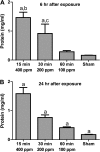
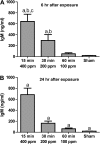
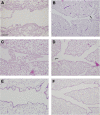
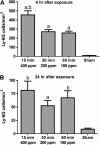
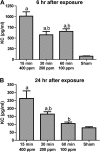
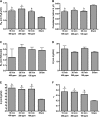
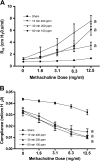
References
-
- Adelson L, Kaufman J. Fatal chlorine poisoning: report of two cases with clinicopathologic correlation. Am. J. Clin. Pathol. 1971;56:430–442. - PubMed
-
- Barrow CS, Kociba RJ, Rampy LW, Keyes DG, Albee RR. An inhalation toxicity study of chlorine in Fischer 344 rats following 30 days of exposure. Toxicol. Appl. Pharmacol. 1979;49:77–88. - PubMed
-
- Bitron MD, Aharonson EF. Delayed mortality of mice following inhalation of acute doses of CH2O, SO2Cl2, and Br2. Am. Ind. Hyg. Assoc. J. 1978;39:129–138. - PubMed
-
- Bliss CI. The relation between exposure time, concentration and toxicity in experiments on insecticides. Ann. Entomol. Soc. Am. 1940;33:721–766.
Publication types
MeSH terms
Substances
Grants and funding
LinkOut - more resources
Full Text Sources
Medical

